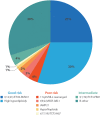Advances in B-cell Precursor Acute Lymphoblastic Leukemia Genomics
- PMID: 31723781
- PMCID: PMC6746003
- DOI: 10.1097/HS9.0000000000000053
Advances in B-cell Precursor Acute Lymphoblastic Leukemia Genomics
Abstract
In childhood B-cell precursor acute lymphoblastic leukemia (BCP-ALL), cytogenetic abnormalities remain important diagnostic and prognostic tools. A number of well-established abnormalities are routinely used in risk stratification for treatment. These include high hyperdiploidy and ETV6-RUNX1 fusion, classified as good risk, while Philadelphia chromosome (Ph) positive ALL and rearrangements of the KMT2A (MLL) gene define poor risk. A poor risk subgroup of intrachromosomal amplification of chromosome 21 (iAMP21-ALL) has been described, in which intensification of therapy has greatly improved outcome. Until recently, no consistent molecular features were defined in around 30% of BCP-ALL (known as B-other-ALL). Recent studies are classifying them into distinct subgroups, some with clear potential for novel therapeutic approaches. For example, in 1 poor risk subtype, known as Ph-like/BCR-ABL1-like ALL, approximately 10% have rearrangements of ABL-class tyrosine kinases: including ABL1, ABL2, PDGFRB, PDGFRA, and CSF1R. Notably, they show a poor response to standard chemotherapy, while they respond to treatment with tyrosine kinase inhibitors, such as imatinib. In other Ph-like-ALL patients, deregulation of the cytokine receptor, CRLF2, and JAK2 rearrangements lead to activation of the JAK-STAT signaling pathway, implicating a specific role for JAK inhibitors in their treatment. Other novel subgroups within B-other-ALL are defined by the IGH-DUX4 translocation, related to deletions of the ERG gene and a good outcome, while fusions involving ZNF384, MEF2D, and intragenic PAX5 amplification (PAX5 AMP) are linked to a poor outcome. Continued genetic screening will eventually lead to complete genomic classification of BCP-ALL and define more molecular targets for less toxic therapies.
Copyright © 2018 the Author(s). Published by Wolters Kluwer Health, Inc. on behalf of the European Hematology Association.
Figures





References
-
- Hunger SP, Mullighan CG. Acute lymphoblastic leukemia in children. N Engl J Med 2015; 373:1541–1552. - PubMed
-
- Harrison CJ, Johansson B. Heim S, Mitelman F. Acute lymphoblastic leukaemia. Cancer Cytogenetics John Wiley and Son Inc, 3rd edHoboken, NJ:2009.
Publication types
LinkOut - more resources
Full Text Sources
Miscellaneous
